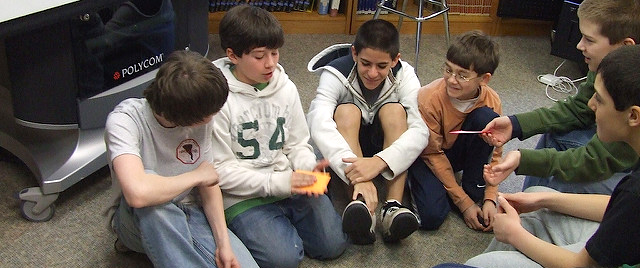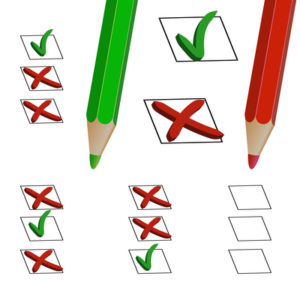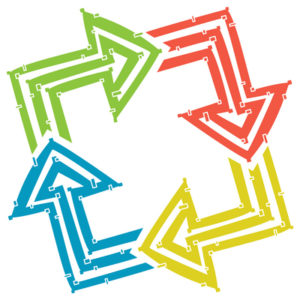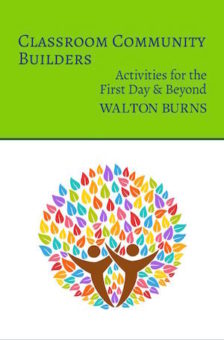Use Community Builders to Help Set Expectations
 By Walton Burns
By Walton Burns
As the early days of back-to-school season are almost upon us (a little too early, perhaps), my Twitter and Facebook timelines are filling up with articles about the best icebreakers and classroom community builders.
In the past week, I’ve read about having students do a selfie scavenger hunt and some new twists on “Find Someone Who….”
However, even the world’s greatest classroom community builder can fail if it’s not done right. And I think one of the biggest mistakes we make is not setting clear expectations.
Perhaps we assume because most community builders are fun, students are willing to buy into them with ease. They’ll pay more attention, follow directions better, and get the point because, after all, it’s fun. So, we think, maybe we don’t want to spoil the fun with too many instructions or by linking it to closely to learning.
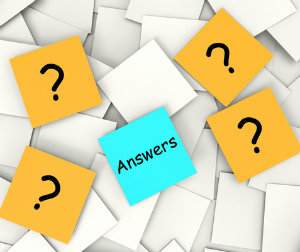
They don’t want group activities to devolve into idle chit chat, and they want to know that you have good reasons for assigning the activities you do. Telling students that a game of 20 Questions helps build their vocabulary and demonstrates the value of thinking as a group will actually help them appreciate the activity more.
What’s more, if you’re doing a classroom community builder in the first day or week of class, your students probably don’t know exactly what to expect of you. They haven’t gotten used to your teaching style or even your speaking style. So, it’s especially important to be clear.
Here are four tips to make your activities succeed by having clear expectations.
1. Teach them the skills they need
You wouldn’t make a student give a speech from Shakespeare without making sure they understood all the language in the speech. Similarly, don’t make students do a group task without teaching them teamwork skills.
One of my favorite community builders involves agreeing as a group on the 5 most important things you need to survive a plane crash. As an ELA/ESL teacher, I find it a great opportunity to practice (a) giving reasons for an opinion, (b) discovering areas of common ground, and (c) using all sorts of signal words and phrases.
But before I can do that, I make sure my students have the skills and language to function in groups. Being clear on what skills you want students to use also prevents a lot of pitfalls like one student dominating the group.
Another great skill to teach is what constitutes an interesting fact. A lot of icebreakers ask students to say something interesting about themselves. Half the time I get students telling me where they are from (which we already know) or their hobby (inevitably something pretty common like watching sports or listening to pop music). Every now and then, I’ll also get a student saying something a bit inappropriate, usually a strong statement of faith.
For students from other cultures particularly, teaching what is socially appropriate is as important as teaching what is interesting. That’s why I have three model “interesting things about me” to use in class, not to mention at training sessions and conferences. (I speak 5 languages. I met the Prime Minister of Vanuatu at a party. I once ate sheep brain.)
2. Be clear about your objectives
It’s generally a good idea to make your learning objectives clear to your students when doing any kind of activity. But with classroom community builders, it’s particularly important because these activities tend to have both learning and interpersonal objectives. The interpersonal objectives, in particular, may be unfamiliar to your students. Students also need to know if you are more interested in the interpersonal or academic side of the activity.
Stating objectives at the beginning of the lesson helps students understand what they are supposed to do. It’s also a great time to explain why these objectives are important. Increase student buy-in into the community-building activity by linking it to long-term goals.
And, a great way to know what their long-term goals are is to do a needs or interest inventory in that first week of class. Needs evaluation activities such as Book Scan, where small groups of students explore the textbook and find topics or units they think are particularly interesting, tell you what students are most excited to learn while also getting them working in groups.
3. Be clear about the result
The best feedback I ever got came from the editor of a writing textbook I was working on. The advice was simple: “Never make discussion the end point of a task.” There’s nothing wrong with asking students to discuss something, but make sure there’s a specific result. Otherwise, the conversation may wander to gossip or last night’s TV shows.
Instead be sure students have a clear goal such as ranking five items in terms of usefulness or agreeing on the top three solutions to a problem out of a list of ten. It’s also a good idea to have them produce something tangible. That way you can monitor how well they are using their time. The product can be as simple as writing down their answers on a piece of paper.
Finally, make sure that you are clear on exactly what the product should look like. The biggest two questions I get regarding writing things down are: “Do you want us to write complete sentences or are phrases ok?” and “Are we going to have to report to the class?” So make sure students know exactly what they have to do and how it’s going to be used.
4. Give good directions
It follows that if you’re going to be specific about the end product of an activity, you should give clear directions. Some community builders and group tasks can be quite complicated, so it’s worth thinking about writing directions down that they can refer to for details. However, verbal instructions tend to be more memorable than written directions and that conversation gives them a chance to ask questions or get clarifications on the spot.
Personally, I like to give a broad overview verbally along with the objectives and take some general questions before handing out more detailed written directions. And to ensure that students are paying attention, you can implement a “3 Then Ask Me” policy where students have to check with three other students about a question before they can ask you. This saves teacher time and also encourages everyone to pay attention because they are responsible for helping the other students.
Conclusion
Building community through fun and engaging activities is important to do at the beginning of school and throughout the year. Make sure you’ve got a great activity. And also make sure that you’re setting your students up to succeed by communicating your expectations well.
Walton Burns is a well-traveled ELA and ESL/EFL teacher, educational materials writer, and publisher. He’s the author of Classroom Community Builders (2017) and 50 Activities for the First Day of School (2016), both from Alphabet Publishing. He lives in Connecticut.
From 2014-17, Walton was part of the leadership team of the Materials Writing Interest Section of the TESOL Association, the international association for English language professionals.
Feature image: Kevin Jarrett

